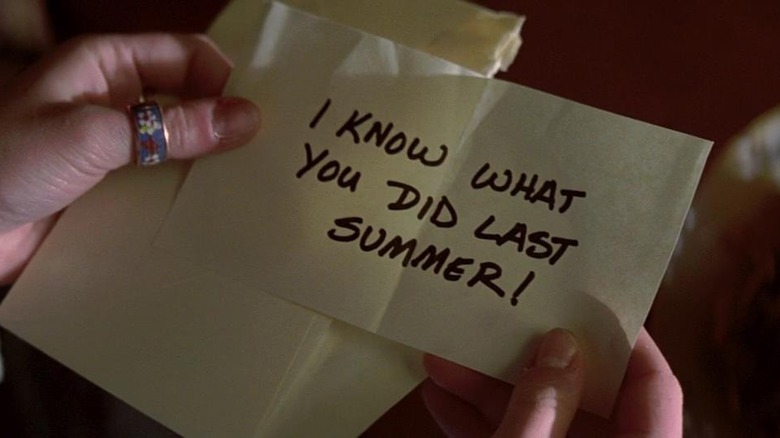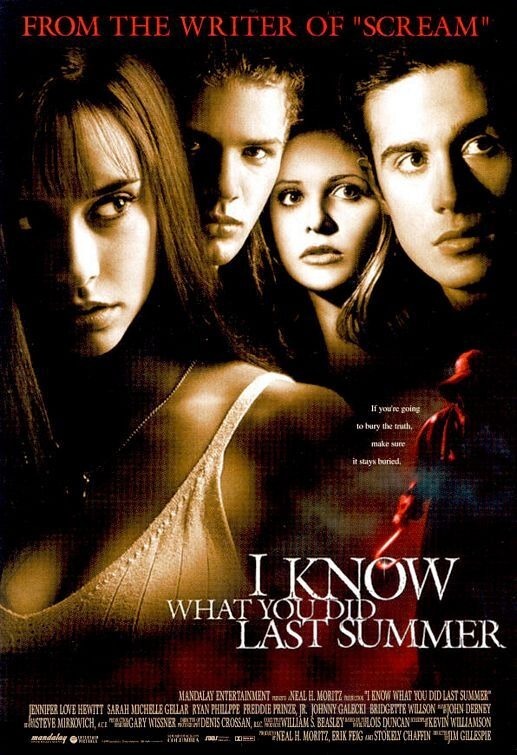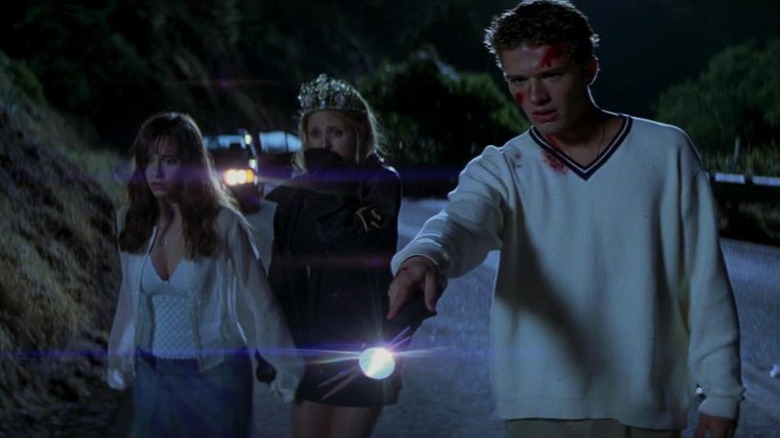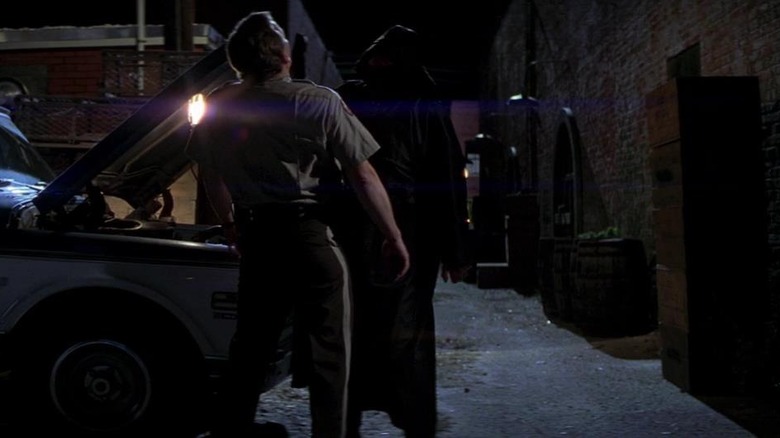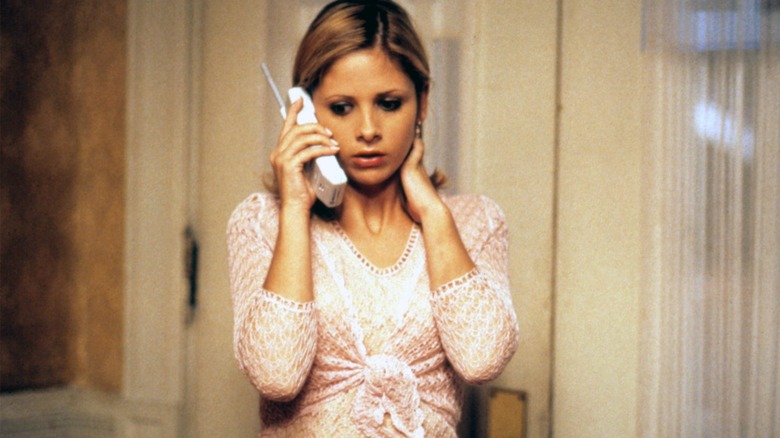Tales From The Box Office: I Know What You Did Last Summer Cashed In On The New '90s Slasher Craze
(Welcome to Tales from the Box Office, our column that examines box office miracles, disasters, and everything in between, as well as what we can learn from them.)
It is hard to imagine a time in popular cinema without slasher films, yet that's exactly what happened in the early '90s once franchises like "Friday the 13th" and "Halloween" had fallen from grace. But in 1996, when director Wes Craven's masterwork "Scream" hit theaters, everything changed. The man who introduced us to Freddy Krueger in "A Nightmare on Elm Street" had revived the slasher genre for a new generation. Now, it was time for every other studio in town to try and cash in. What better way to do that than to make another movie by the guy who wrote "Scream?"
In a hurried attempt to capitalize on the success of the renewed slasher craze, Columbia Pictures scooped up another Williamson script that couldn't get made before Ghostface became a genre icon, but was now a hot-ticket item. The movie? "I Know What You Did Last Summer," arguably the most successful slasher series to arrive in the wake of "Scream." Or, at the very least, one very successful movie that spawned two far less successful sequels.
In honor of the film's 25th anniversary, we're looking back at its hurried road to the screen, how it ensured the survival of the slasher, and what lessons we might be able to learn from its success all these years later. Let's dig in, shall we?
The movie: I Know What You Did Last Summer
It is genuinely impressive how quickly Sony and Columbia managed to cash in on the goodwill "Scream" had earned with moviegoers. That movie hit theaters on December 20, 1996, and "I Know What You Did Last Summer" was in theaters in October of 1997. Wisely, the studio execs rushed the film into production when they saw the dollar signs on the wall, despite the fact that Williamson's script had been kicking around for several years and couldn't get made. But when you can market your movie by saying it is "From the writer of Scream," it suddenly makes a lot of sense.
It is worth noting that this film was not just a retread of what Craven and Williamson had done with "Scream." For those who might need a little refresher, "I Know What You Did Last Summer" centers on a group of four friends who accidentally run over a fisherman one fateful night and dump his body, leaving them with a horrible secret to conceal. A year later, a frightening letter arrives letting them know that someone saw what they did, which just so happened to be in the summer. Next thing we know, a hook-handed killer in a raincoat is trying to pick good-looking young people off, one-by-one.
Jim Gillespie was tasked with adapting Williamson's work for the screen, serving as his feature directorial debut. "My point was not to make 'Scream.' Kevin wrote it, Kevin didn't write this as 'Scream 2,'" Gillespie said in reflection several years back. "There were a couple of lines that were very Kevin-esque, but he wasn't trying to do that whole post-modern thing 'cos he'd just done it with 'Scream.' We deliberately were not going for that sort of thing. It was meant to be kind of a stand-alone revisit of those classic '80s horror films."
Perfect timing, perfect cast
One thing that this movie absolutely had going for it was timing. That much was clear. Rarely in Hollywood can you get that lucky. It would be like if Warner Bros. had just happened to have a new superhero movie ready to go about a relatively unknown but marketable character nine months after "Iron Man" came out. It was just perfect. But the other key element was putting together a downright murder's row (pun!) of young, up-and-coming stars. Jennifer Love Hewitt led the way, having been poised for a breakout role after her years as a child star.
Hewitt was surrounded by similar talent awaiting their first big hit: Ryan Phillippe, who had starred in "One Life to Live" several years earlier; Freddie Prinze Jr., who had been making inroads with guest spots on shows like "Family Matters; and Sarah Michelle Gellar, who had just debuted as the lead on "Buffy the Vampire Slayer" earlier that year. Said Gillespie:
"I cast them all. [Jennifer] Love [Hewitt] was always going to be Julie, and she was cast first. We actually had made an offer to Reese Witherspoon first off. Reese came in and met us, but ultimately didn't want to do it. But she pointed us to Ryan, funnily enough. They were dating at this time. We asked her who the hottest guy was, in her opinion, and she said Ryan Phillippe."
And so, the stage was set. A perfect cast, the perfect writer, a fresh director, and an audience-friendly premise at the perfect time. The perfect storm was brewing for this movie to make a killing.
The financial journey
"I Know What You Did Last Summer" opened on October 17, 1997, just in time for the Halloween season. It debuted at number one on the charts, taking in $15.8 million, topping the other newcomer that weekend, "The Devil's Advocate" ($12.1 million). But that was just the beginning, as the film would go on to remain atop the charts for two more weeks, not surrendering the crown until "Starship Troopers" hit theaters in early November. The fact Sony was able to hit that Halloween corridor on such a short timeline was nothing shy of impressive.
Against a mere $17 million budget, the film took in a whopping $72.2 million domestically along with a healthy $53 million overseas for a grand total of $125.2 million. Or, to put it another way, nearly 7.5 times its budget. Not to mention that this was at a time where home video sales and cable rights would have been significant in terms of cash flow. Needless to say, a new franchise was born.
Sony rushed a sequel into production in the form of "I Still Know What You Did Last Summer," which arrived the following year, missing that Halloween timeframe and, instead, arriving in mid-November. But the heat had died down and the sequel earned a mere $40 million against a larger $24 million budget. A third sequel, "I'll Always Know What You Did Last Summer," went direct-to-video in 2006. A flash in the pan that burned very bright but burned off very quickly.
The lessons contained within
On the one hand, Sony and Columbia looked like geniuses for getting this movie into production and in theaters as soon as they did. It is one of the best examples of striking while the iron is hot. It also helped to further cement the idea that slashers could be more than recycled franchises and that "Scream" wasn't just a one-off. Much of what would come in the years that followed arguably owes just as much to this movie, which proved Ghostface wasn't a fluke.
The flipside, though, is that the studio did what Hollywood so often does: they got greedy. There's a reason that Gillespie didn't direct the sequel, because he knew they were rushing it. There's a reason that "I Still Know What You Did Last Summer" didn't make a third of what the original made, because it very much felt and looked like a rushed, cash-grab sequel. There's a reason it took eight years for another sequel to arrive and there's a reason it went direct to video. Yes, we had the show on Prime Video last year, but that burned out quickly too. There's a pattern here.
Unfortunately, this was an example of wanting too much, too fast. Would we have eight "I Know What You Did Last Summer" films focused on hook-handed fishermen now if the studio had taken some time to deliver a better sequel? Maybe. Maybe not. But it's clear that rushing this helped nobody. The other thing is, as Gillespie points out, that this movie worked because they let it take its time.
"We did a thing that you would never really get away with today, which is the slow-build. Get to know the people before you start chopping them up, so you care about them a bit. They seem more real to you. It's what Ridley [Scott] did with Alien. It's 40 minutes before anything happens in Alien."
Fair to say, that slow and steady approach paid off in the film. It might have paid off to take that approach in the real world as well. But that's easy for me to say 25 years removed with no skin in the game.

